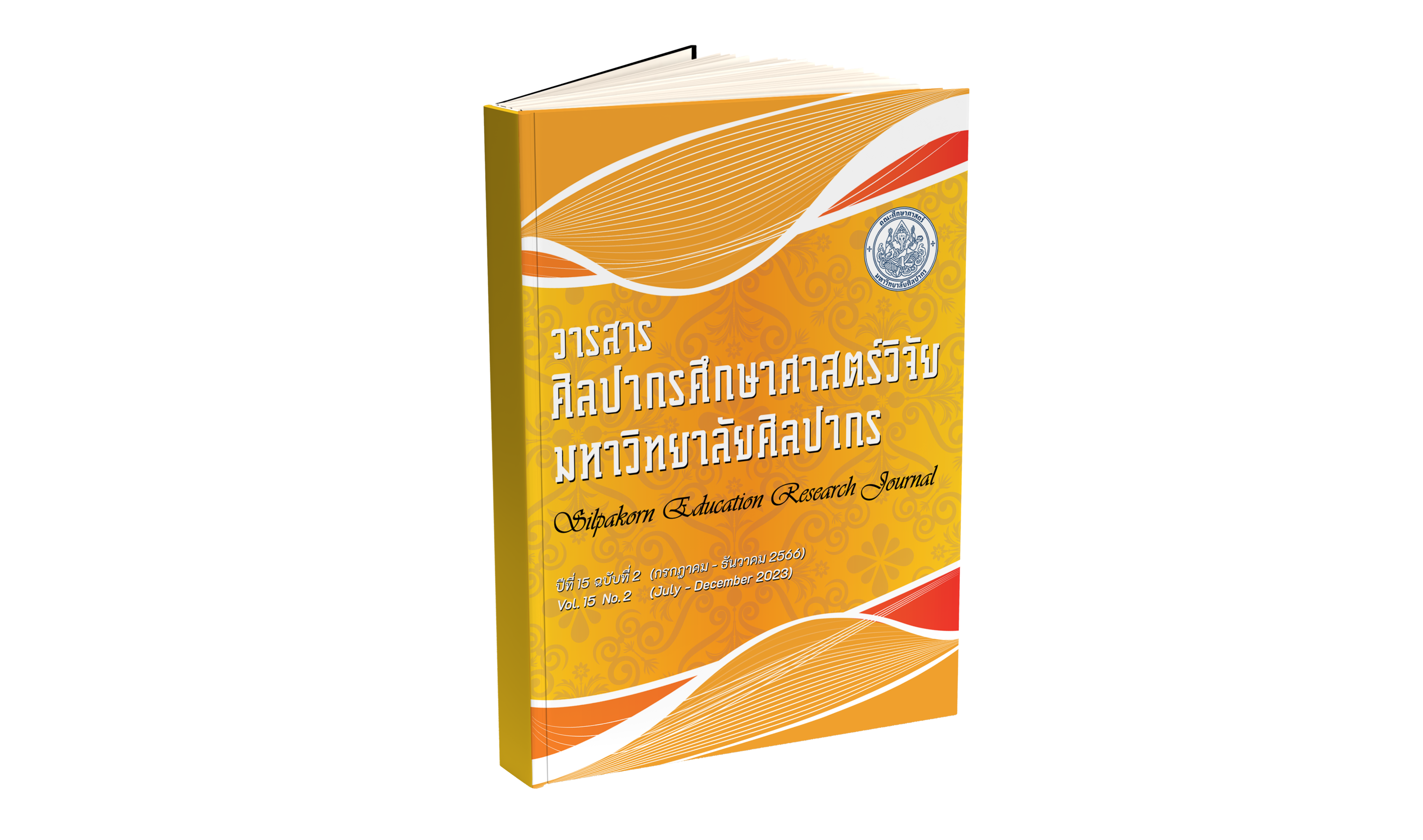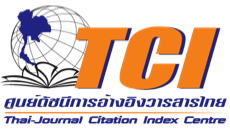ผลการใช้กลยุทธ์ SCIM-C ที่มีต่อความเข้าใจบริบททางประวัติศาสตร์ของนักเรียนมัธยมศึกษาปีที่ 2
คำสำคัญ:
กลยุทธ์ SCIM-C, ความเข้าใจบริบททางประวัติศาสตร์, การจัดการเรียนรู้ประวัติศาสตร์บทคัดย่อ
การวิจัยครั้งนี้มีวัตถุประสงค์เพื่อ 1) ศึกษาความเข้าใจบริบททางประวัติศาสตร์ของนักเรียนมัธยมศึกษา ปีที่ 2 ที่ได้รับการจัดการเรียนรู้ประวัติศาสตร์โดยใช้กลยุทธ์ SCIM-C และ 2) ศึกษาพัฒนาการความเข้าใจบริบท ทางประวัติศาสตร์ของนักเรียนมัธยมศึกษาปีที่ 2 ที่ได้รับการจัดการเรียนรู้ประวัติศาสตร์โดยใช้กลยุทธ์ SCIM-C กลุ่มตัวอย่างที่ใช้ในการวิจัยครั้งนี้ คือ นักเรียนมัธยมศึกษาปีที่ 2/1 โรงเรียนเทพศิรินทร์ลาดหญ้า กาญจนบุรี สังกัดสำนักงานเขตพื้นที่การศึกษามัธยมศึกษากาญจนบุรี ภาคเรียนที่ 1 ปีการศึกษา 2566 จำนวน 27 คน เครื่องมือที่ใช้ในการทดลอง คือ แผนหน่วยการจัดการเรียนรู้ประวัติศาสตร์โดยใช้กลยุทธ์ SCIM-C จำนวน 3 แผน และเครื่องมือที่ใช้ในการเก็บรวบรวมข้อมูล คือ แบบวัดความเข้าใจบริบททางประวัติศาสตร์ จำนวน 3 ฉบับ วิเคราะห์ข้อมูลโดยการหาค่าเฉลี่ย ค่าส่วนเบี่ยงเบนมาตรฐาน และวิเคราะห์ความแปรปรวนแบบวัดซ้ำ
ผลการวิจัยพบว่า 1) ความเข้าใจบริบททางประวัติศาสตร์ของนักเรียนมัธยมศึกษาปีที่ 2 ที่ได้รับ การจัดการเรียนรู้ประวัติศาสตร์โดยใช้กลยุทธ์ SCIM-C อยู่ในระดับดีมาก และ 2) พัฒนาการความเข้าใจบริบท ทางประวัติศาสตร์ของนักเรียนมัธยมศึกษาปีที่ 2 ที่ได้รับการจัดการเรียนรู้ประวัติศาสตร์โดยใช้กลยุทธ์ SCIM-C สูงขึ้นอย่างมีนัยสำคัญทางสถิติที่ระดับ .05 ทั้ง 3 ระยะ
เอกสารอ้างอิง
A-Romchuen, J. (2020). Development of Critical Historical Consciousness Using Instruction Based on SCIM-C Strategies for High School Students. Master of Education Thesis Program in Educational Science and Learning Management Graduate School Srinakharinwirot University. (in Thai)
Aiaosriwong, N. and Pattiya, A. (1982). Historical Evidences in Thailand. Bangkok: Duang Dee Printing. (in Thai)
Barton, K. C. and Levstik, L. S. (2004). Teaching History for the Common Good. Mahwah: Erlbaum. Brahmaboon, S. (1978). Status of History Subjects in Thailand. Bangkok: Chulalongkorn University. (in Thai)
Burns, R. (2004). “Historical Empathy as Perspective Recognition.” In Teaching History for the Common Good. London: Lawrence Erlbaum Associates.
Eiamprapai, W. (1992). Historical Evidences. Bangkok: OS Printing House. (in Thai)
Endacott, J. and Brooks, S. (2013). “An Updated Theoretical and Practical Model for Promoting Historical Empathy”. Social Studies Research and Practice 8(1): 41-58.
Gottschalk, L. (1982). Understanding History: A Primer of Historical Method. Bangkok: ThaiWatana Panich. (in Thai)
Hantrakool, P. (2013). “Teaching Technique and Using Teaching Innovation in History”. In History, Religion, Culture, and Education: A Collection of Thai Studies Articles to Recall Professor Ishii Yoneo. Bangkok: Dansutta Printing. (in Thai)
Havekes, H., Van Boxtel, C., Coppen, P.A. and Luttenberg, J. (2012). “Knowing and Doing History: AConceptual Framework and Pedagogy for Teaching Historical Contextualisation”. International Journal of Historical Learning Teaching and Research 11(1): 72-97.
Hicks, D., Doolittle, P. and Ewing, E. T. (2004). “The SCIM-C Strategy: Expert Historians Historical Inquiry and Multimedia”. Social Education 68(3): 222-225.
Hicks, D. and Doolittle, P. (2008). “Fostering Analysis in Historical Inquiry Through Multimedia Embedded Scaffolding”. Theory and Research in Social Education 36(3): 206-232.
Hicks, D. and Doolittle, P. (2009). “Chapter 6 Multimedia-Based Historical Inquiry Strategy Instruction: Do Size and form Really Matter?”. In Research on Technology in Social Studies Education. North Carolina: Information Age Publishing.
Holcomb, L., Beal, C. and Lee, J. K. (2011). “Supersizing Social Studies Through the Use of Web 2.0 Technologies”. Social Studies Research and Practice 6(3): 102-111.
Huijgen, T., Holthuis, P., Van Boxtel, C. and Grift, W. v. d. (2019). “Promoting Historical Contextualisation in Classrooms: An Observational Study”. Educational Studies 45(4): 456- 479.
Kasetsiri, C. (2008). Ayutthaya Studies Handbook for Teachers and Students. Bangkok: Social Sciences and Humanities Textbooks Foundation. (in Thai)
Lee, J. and Friedman, A. M. (2009). Research on Technology in Social Studies Education. North Carolina: Information Age Publishing.
Lee, J. K. and Clarke, W. G. (2004). “Studying Local History in the Digital Age: The Story of Asaph Perry”. Social Education 68(3): 203-207.
McCully, A. (2012). “History Teaching, Conflict and the Legacy of the Past”. Education Citizenship and Social Justice 7: 145–159.
National Council for the Social Studies. (2013). The College Career and Civic Life (C3) Framework for Social Studies State Standards: Guidance for Enhancing the Rigor of K-12 Civics, Economics Geography and History. Silver Spring MD: NCSS.
Pongsripian, W. (2000). “The Teachers and Teaching Thai History”. In Instructional History Handbook: How to Learn Thai History. Bangkok: Religious Press. (in Thai)
Reisman, A. and Wineburg, S. (2008). “Teaching the Skill of Contextualizing in History”. The Social Studies 99(5): 202-207.
Saksoong, A. (2011). Historical Thinking and Research Methodology. Songkhla: Namsilp Atvertise. (in Thai)
Scheuerell, S. K. (2015). “SCIM-C: A Step-by-Step Guide to Lessons Using the Student Historian Approach”. In Technology in the Middle and Secondary Social Studies Classroom. New York: Routledge.
Seixas, P. (2006). Benchmarks of Historical Thinking: A Framework for Assessment in Canada. Vancouver: Centre for the Study of Historical Consciousness.
Sripahol, S. (2008). “Instructional Management of History in School”. Journal of Teachers’ Professional Development 107(11): 87. (in Thai)
Suwathanpornkul, I. (2019). Educational Research : Concepts and Applications. Bangkok: Chulalongkorn University. (in Thai)
The College Board. (2015). AP United States History Including the Curriculum Framework, Updated Fall 2015. New York: The College Board.
The Stanford History Education Group. (2002). Reading Like a Historian. [Online]. Retrived May 5, 2021 from https://sheg.stanford.edu/history-lessons.
Tosila, C. (2012). Development of Instructional Process by Using Historical Method to Enhance Historical Thinking Skills of Eighth Grade Students. Doctor of Philosophy Thesis Program in Department of Curriculum and Instruction Faculty of Education Chulalongkorn University. (in Thai)
Van Boxtel, C. and Van Drie, J. (2012). “That’s in the Time of the Romans! Knowledge and Strategies Students Use To Contextualize Historical Images and Documents”. Cognition and Instruction 30(2): 113-145.
Van Drie, J. and Van Boxtel, C. (2007). “Historical Reasoning: Towards a Framework for Analyzing Students’ Reasoning About the Past”. Educ Psychol Rev 20(2): 87–110.
VanSledright. (2002). In Search of America’s Past: Learning to Read History in Elementary School. New York: Teachers College Press.
Wadhwani, R. D. (2016). “Entrepreneurship in Historical Context: Using History to Develop Theory and Understand Process”. In A Research Agenda for Entrepreneurship and Context. Edited by F. Welter and W. B. Gartner. Cheltenham: Edward Elgar Pub.





